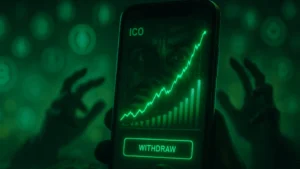On a humid evening in late 2017, Li Wei stared at her phone. Her balance in the app had tripled overnight. The “token” listing flashed green. She tapped “withdraw,” heart pounding. But hours passed. Nothing arrived. The app went dark.
She wasn’t alone. Across the world, thousands were realizing the same thing: their money had vanished. The “2017 token scam” nightmare had begun — an age where trust was tokenized, traded, and then stolen in the blink of an eye.
The Machinery Behind the 2017 Token Scam
The 2017 token scam wave began with promises that felt revolutionary. Anyone could create a new cryptocurrency through an Initial Coin Offering (ICO), sell tokens to investors, and fund a “project.”
Most claimed to build platforms for lending, trading, or social networking — but many had no code, no team, and no real plan. All they had was a website, a whitepaper, and a dream polished by greed.
Telegram channels buzzed with “moon talk.” Websites had ticking countdown timers — “Only 48 hours left!” — and fake testimonials from supposed early investors. Screens flashed, wallets filled, and money poured in faster than anyone could question where it was going.
Here’s where it gets worse. Once enough crypto was collected, many founders quietly disappeared. Some shut down websites overnight. Others staged fake “hacks” to cover their exit. And the crowd, hypnotized by easy profit, didn’t realize it was all theater — until it was far too late.
Victims of the 2017 ICO Fraud — The Human Cost
Behind every blockchain address was a heartbeat. A factory worker in Vietnam emptied his savings into Pincoin, believing he was investing in the future. A retired teacher in Ohio joined AriseBank, convinced it was the “first decentralized bank.” A university student in Canada borrowed from friends to join PlexCoin, chasing that 1,354% promised return.
One victim wrote on a forum: “I sold my motorbike. I believed the ads. I believed I could make life better. Instead, I got nothing.”
As the scams unraveled, chat groups turned from hype to horror. Thousands begged for withdrawals. Some founders mocked their investors before vanishing. And while victims faced sleepless nights and empty accounts, the scammers flaunted new cars and seaside mansions.
The greed was enormous. The suffering was greater.

The Villains and the Fallout: Inside 2017’s Biggest Token Scams
Let’s name the monsters behind the masks.
-
PlexCoin (Dominic Lacroix) — Promised 1,354% profit in 29 days. The SEC froze $15 million in assets and charged the founder with fraud.
-
AriseBank (Jared Rice & Stanley Ford) — Claimed to be FDIC-insured and raised $600 million. Shut down by the SEC in early 2018 for false claims.
-
Pincoin / iFan (Modern Tech, Vietnam) — Vanished with $660 million from over 32,000 victims, one of Asia’s largest crypto frauds.
-
Centra Tech (Sohrab Sharma, Robert Farkas, Raymond Trapani) — Backed by celebrity influencers Floyd Mayweather and DJ Khaled, this scam raised $32 million. All founders were later convicted.
Each case shared one pattern: confidence, charisma, and complete disregard for human pain.
Justice Delivered, But Damage Done
Some justice came, but slowly.
PlexCorps’ founders faced fines and injunctions. AriseBank’s operators were banned from financial services. Centra Tech’s leaders served prison terms.
But here’s the real tragedy — the stolen crypto was mostly gone, laundered through mixers and shell wallets. Prosecutors said, “This was fraud, not innovation.”
One victim told reporters, “I’ll never trust an online investment again. I wasn’t greedy. I was just hopeful.”
Hope — that’s what every scammer in 2017 preyed upon.

Lessons from the ICO Nightmare — How to Avoid the Next Scam
If 2017 taught us anything, it’s that greed and ignorance make perfect prey. To avoid becoming the next statistic, remember these red flags:
- Guaranteed returns — no legitimate investment guarantees profit.
- Pressure to recruit friends or family.
- Offshore or anonymous team — no clear founders or registration.
- No proof of reserves or verifiable audits.
- Claims of “AI trading” or “secret algorithms.”
- Celebrity endorsements with no real project.
- Unverifiable token utility or code.
Ask before you invest: Who holds the keys? Where’s the code? Can I verify the company? If the answers vanish — so will your money.
Horror Epilogue — The Aftermath of the ICO Fruad 2017 Token Scam
Even today, stolen funds from the 2017 token scam era still move through the blockchain’s dark corners. New scams have evolved, wearing the mask of “DeFi” or “Web3,” but the essence remains the same: promise, profit, vanish.
For the victims, it wasn’t just about money — it was about broken trust. For the rest of us, their pain stands as a warning: hope without caution is a predator’s playground.
The lesson lingers in the digital void — a whisper in the dark:
Don’t trust the shine. It’s often the reflection of someone else’s greed.
Resources
[3] Securities and Exchange Commission. “PlexCorps, et al. litigation release.” Dec. 1, 2017.
[4] Securities and Exchange Commission. “SEC Halts Alleged Initial Coin Offering Scam (AriseBank).” Jan. 30, 2018.
[5] Federal Bureau of Investigation. “Cryptocurrency Investment Fraud.” (Victim Services).
[6] Securities and Exchange Commission. “SEC Charges Founder With Fraudulent ICO.” Dec. 11, 2019.
Related Articles
Mining Pool Scams: How Fake Mining Operations Rob Investors
NFT Scams: Celebrity Endorsement Frauds That Cost Fans Millions









